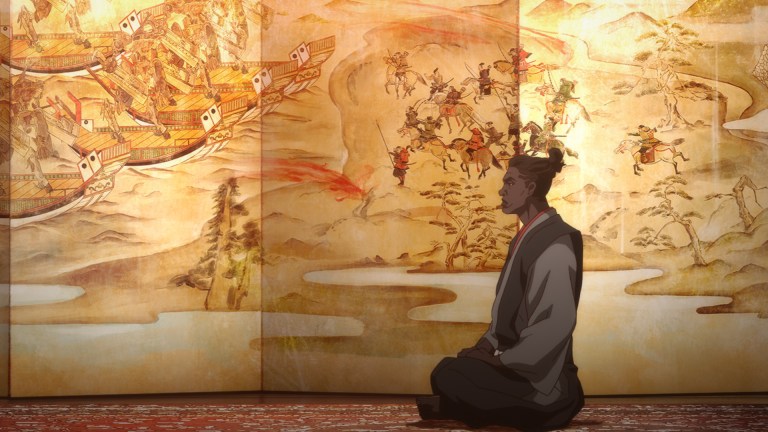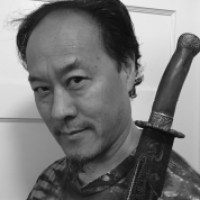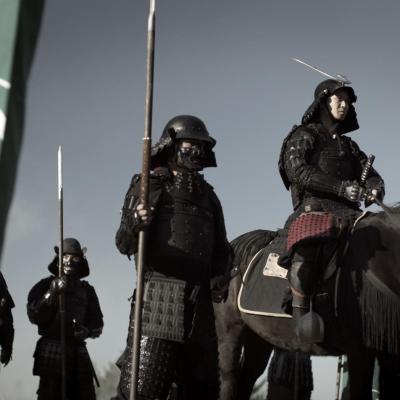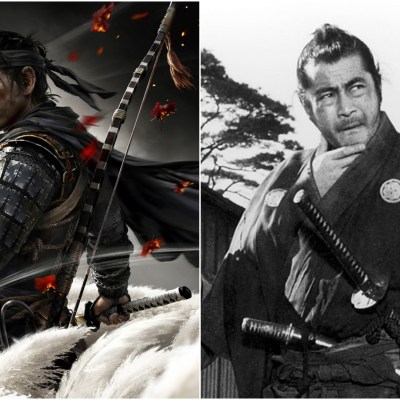Yasuke: The Real History Behind Japan’s Black Samurai
The new Netflix anime Yasuke pits one of history’s most interesting Samurai against sorcerers, demons, and robots. Here is some of the real history behind the warrior.

Yasuke is a groundbreaking new anime that fuses fact and fiction. The six-episode original series streaming on Netflix now is the brainchild of comic artist and animation director LeSean Thomas (Cannon Busters, The Boondocks). The titular role in Yasuke is voiced by Oscar-nominated LaKeith Stanfield (Sorry To Bother You, Knives Out) who is also one of the producers. Yasuke comes from Japan’s animation house MAPPA (Maruyama Animation Produce Project Association) who also produced noteworthy animes like Attack on Titan, Rage of Baphomet, and Punch Line. Grammy-nominated artist Flying Lotus (a.k.a. FlyLo) provides the soundtrack and is also another producer.
Yasuke is somewhat in the same vein as Afro Samurai or Samurai Jack in propelling an iconic Samurai figure into a rich fantasy world.
“It just sits right alongside Afro Samurai and Samurai Jack,” acknowledges Thomas, “They’re going to be compared regardless because those are the only three that are being pushed to the Western entertainment. So, it’s inevitable.”
However, where those two were set in alternate futures, Yasuke takes in an alternate past.
Yasuke combines bots, mechs, werebears, and sorcery with actual Japanese history. There was a real historical figure named Yasuke. He was a Black samurai who lived in the late 1500s. His story is somewhat murky, but there are still some important things we do know about the legendary warrior.
The Real Black Samurai
The real Yasuke lived during Japan’s Sengoku period (1467-1615) when the country was torn by feudal war. This was the glorious era of samurai, Japan’s legendary military nobility.
Many of the exact details of Yasuke’s life history are muddled. Yasuke is mentioned in passing in a few different accounts chronicling his time in Japan and there are a few images of a dark-skinned warrior in period paintings that are assumed to be him. The most significant reference is a surviving journal that was kept by a samurai contemporary to Yasuke named Matsudaira Ietada (1555-1600). The journal, known as the Ietada Nikki (Nikki means ‘diary’), documented Ietada’s experiences from 1575 to 1594. Ietada describes Yasuke as standing “6 shaku and 2 sun (roughly 6’ 2”)” and that his “skin was black like charcoal.” Thomas used the Ietada Nikki as a jumping off point for the anime.
“There are only the diaries that are mentioned and even those are interpreted,” says Thomas.
The dates of Yasuke’s birth and death, as well as his country of origin, are unknown. There are many theories about his nationality. Some theorize he hailed from Ethiopia, Mozambique, or Sudan. Yasuke opts for the Yao people of Southeast Africa, which is a valid theory. The ‘Ya’ in Yasuke may have been a Japanese phonetic translation of Yao and ‘suke’ can mean ‘assistant’.
Yasuke landed in Japan in 1579, an event that is dramatized in Yasuke. He came to Japan in the service of Alessandro Valignano (1539-1606), an Italian Jesuit missionary who was among the first to propound Catholicism to China, India, and Japan. After arriving, Valignano and Yasuke travelled to Kyoto to pay respects to Oda Nobunaga (1534-1582).
Nobunaga is one of the most colorful feudal lords of Japan. History paints him as both champion and villain – champion for being the ‘great unifier’ of Japan and villain for the brutal bloody path he cut across the country to unify it. Nobunaga was open to free trade during a time when Japan was traditionally dismissive of outsiders. He was fascinated by the outside world and was known to dress in foreign attire and preferred European red wine over rice wine. When Nobunaga met Yasuke, he was convinced that his skin had been dyed with ink and ordered him to be stripped and washed. Once he discovered that Yasuke was indeed Black, he took great interest in him and by some accounts, gave him some money.
Yasuke takes liberties with this story. After all, there were no bots or mechs in the 16th century.
“Since Yasuke doesn’t have an owned estate, no one owns his character – his story was up for interpretation,” Thomas says. “And for me, by the time Flying Lotus came on board, I knew I wanted to tell a story that was removed from history so that we can create a new action hero and celebrate him through this adventure story.”
Instead of travelling with a missionary, Yasuke arrives in Japan in the service of a European trader. He meets Nobunaga by chance as the warlord is examining the trader’s wares at the docks of a Nanban trade port. Nanban trade refers to a period when Portuguese merchants and missionaries landed in Japan in the mid-16th century. Portuguese sea trade was prevalent at that time.
In the anime, Nobunaga is impressed by Yasuke after witnessing him in a street fight where he demonstrates great honor. The incident of Nobunaga having Yasuke washed is reenacted, and then Nobunaga takes him on as a retainer. History is unclear about exactly when the real Yasuke entered Nobunaga’s service. However, Yasuke may have been Nobunaga’s only non-Japanese retainer and perhaps for that reason, he was one of Nobunaga’s favorites.
Ninjas Like Snake Eyes
The narrative of Yasuke jumps back and forth through time as it retells its titular hero’s backstory under Nobunaga. Yasuke is depicted as having a pivotal role in the Tensho Iga War in 1581. With their unusual face masks, the defenders of Iga resemble Snake Eyes from G.I. Joe, a nod to animated ninjas. Historically, some 10,000 Iga defenders fought off 42,000 of Nobunaga’s troops using fierce guerilla and stealth tactics. These warriors became the foundation of ninja legends in this region. Famous among them was Iga ninja leader Hattori Hanzo, who is also referenced in Yasuke. If the name Hanzo rings familiar (and you are unfamiliar with ninja history), it’s because Tarantino poached it for Kill Bill. In that film, Hanzo was the sword maker played by veteran Japanese action star, Sonny Chiba.
It’s not clear if the real Yasuke participated in the Tensho Iga War, but given his timeline, it’s certainly plausible. He is documented as fighting for Nobunaga in the Battle of Tenmokuzan the following year. It was after that battle when Yasuke met Ietada who documented it in his journal. Yasuke was present at the Honno-Ji, the temple where Nobunaga committed seppuku. In the anime, Yasuke serves as Nobunaga’s kaishakunin – the person appointed to behead whoever is undertaking seppuku. No one knows who Nobunaga’s kaishakunin really was, but by some accounts, Yasuke was charged to deliver Nobunaga’s head and sword to his son, Nobutada.
Ritual Suicide and Sacred Beheading
In cinema, as in this anime, seppuku beheadings are graphic. However, it was a sacred ritual that required an exceedingly difficult cut. That cut is still practiced, just in case, by contemporary practitioners of Iaido, the art of sword drawing and cutting. Given the hallowed nature of seppuku, a head skittering across the floor is tacky. The kaishakunin’s cut must be exact. It must sever the spine but not the windpipe, so the head falls gently into the lap. One of the last recorded instances of seppuku was by acclaimed writer Yukio Mishima (1925-1970). His kaishakunin failed three times attempting to make that final cut, and another had to take over.
Following the incident at Honno-Ji, the true fate of Yasuke is unclear. Yasuke did join Nobunaga’s son Nobutada, but that didn’t last long. Nobutada was forced to commit seppuku that same year. Some accounts allege that Yasuke was captured and exiled to a Jesuit mission in Kyoto. There is a story about him fighting for the Jesuits in the Battle of Okitanawate in 1582, but that is his final chapter in the history books. Yasuke takes place twenty years after the Honno-Ji but given that the anime has him battling giant robots, such liberties are allowed.
To Be a Samurai is To Serve
Despite being fantasy, Yasuke captures the essence of samurai culture well. The most notable digression is how Yasuke is constantly berated by other samurai about his servitude. The word ‘samurai’ derives from saburau, which means ‘to wait upon’ or ‘accompany,’ essentially ‘to serve.’ The legends of samurai being great warriors eclipses their fundamental role as servants to their lord. Not only did samurai serve as swordsmen, but they also performed more mundane tasks for their lords like tax collecting.
Read more
That intense dedication to servitude, a commitment to the death, is what made them legendary. Throughout Yasuke, the titular hero honors this ideal of servitude to Nobunaga, and to others, which preserves the core samurai principle. The only awkwardness is that other samurai wouldn’t berate him for such behavior. They would respect that because it’s a goal to which they all aspire.
Yasuke has been depicted in movies, books, and anime before. Last year’s African Samurai: The True Story of Yasuke, a Legendary Black Warrior in Feudal Japan by Geoffrey Girard and Thomas Lockley was a scholarly documentation of his life. And there are some children’s books including Kuro-suke by Kurusu Yoshio and Yasuke: The Legend of the African Samurai by Jamal Turner.
In 2017, Lionsgate began developing Black Samurai, which was originally to be scripted by Gregory Widen (Highlander). The project progressed with Doug Miro (Narcos) replacing Widen under a cooperative effort between Erik Feig’s Picturestart, Mike De Luca’s De Luca Productions and Stephen L’Heureux’s Solipsist. Chadwick Boseman (Black Panther) was cast as Yasuke but production ceased with his untimely passing.
While fantasy, Yasuke pays homage to one of history’s most remarkable warriors. This fortifies this anime’s depth. Not only is it an entertaining introduction to a glorious piece of history, Yasuke has heart. It captures the spirit of an outstanding real-life hero who is often overlooked and brings him to an entirely new audience with dignity and honor.
Clearly, Thomas’s Yasuke is entertainment, not a history lesson. However, he’ll be delighted if it brings more spotlight to one of the most intriguing samurai warriors of all.
“Even through Covid, we worked really, really hard with all the restrictions and limitations and voice acting. I’m just really happy that we got it done,” he says.
Yasuke is available to stream on Netflix now.



